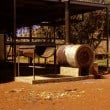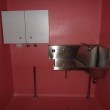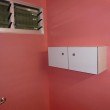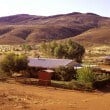B5.1 Performance of health hardware in households with more people
When designing new houses, upgrading a house or developing a maintenance program, find out from residents and housing managers how many people are likely to be living in and using the health hardware in the house and surrounding yard area.
Obtain population data from many sources such as residents, the local or regional housing manager, community council, health clinic and local store. Also consider how seasonal variations and peak population periods need to be accommodated. These data sources may vary significantly, but the combined data will allow a better estimate of the potential household size and ensure the house is designed to minimise the negative impacts of crowding.
National data from over 6,000 houses shows that 42% of houses have a population of more than 5 people, a decrease of 9% since 2013, with houses with a population of 0-4 people at 57%.
There is also a significant variation between the living area per person available in households.
Where less people (0 – 4 people) live in the house, there is an average 48 square metres per person is available.
In larger households (10 people or more), there is an average of only 8.8 square metres per person is available.
Design and Specification
Ensure
- B5.1 .1.
health hardware such as taps, shower fittings, laundry tubs, power points and light switches are good quality, will withstand high usage in large households and can be used by people with disabilities
- B5.1 .2.
that enough hot water is available to meet the needs of the household and cope with fluctuations in household population
- B5.1 .3.
there are clothes washing (ideally washing machines) and drying facilities sufficient to meet the needs of the household
- B5.1 .4.
toilets and wet area services meet the requirements of the household size, and are separated so that shower, laundry and toilet facilities can be used by several people at once
- B5.1 .5.
at least one toilet and shower area is sized to be accessible to people who use wheelchairs or can be adapted in the future to be fully accessible
- B5.1 .6.
the wastewater removal system is adequate for the population size and can cope with expected peak loads in the house
- B5.1 .7.
at least two options for cooking food have been provided (eg a place for an electric fry pan as well as a stove top), and the food storage and preparation areas in the kitchen are sufficient for household size
- B5.1 .8.
the bedrooms have heating and/or cooling systems suited to the climate, and people will not have to share one cooled or heated common space for sleeping
- B5.1 .9.
the plan of the house, and the location on site, can accommodate future alterations and additions.
Consider
- the privacy needs of people using the house and implications of any local cultural requirements
- reducing the operating costs of all health hardware by using energy efficient options for, in order of priority: hot water, cooking, heating and cooling
- installing a second outdoor toilet such as a dry toilet, or a second toilet and wet area facilities in the house that can easily be accessed from outside areas
- installing outdoor cooking facilities as well as an indoor kitchen
- specifying robust windows, insect screens and doors and all associated hardware - catches, handles, doorstops, hinges - that will withstand high usage
- having solid core or semi-solid core doors throughout the house, because they are more durable, require minimal maintenance and provide better sound proofing between rooms
- specifying durable floor coverings and wall finishes that will withstand high levels of use
- that bedrooms will often be used by more than one person and should be sized to fit two or three mattresses and associated storage space
- the orientation, shading, insulation, and installation of active heating and cooling systems to moderate the local climate and allow people to use all parts of the house throughout the day and night
- locating a hand basin in bedrooms used by people who have long term illnesses or reduced mobility.
Real world examples of Solutions
-
 Additional cooking areas
Additional cooking areas -
 Additional cooking areas
Additional cooking areas -
 Additional cooking areas
Additional cooking areas -
 High level clothes hooks
High level clothes hooks -
 High secure storage
High secure storage -
 High secure storage
High secure storage -
 Clothes washing facilities
Clothes washing facilities -
 Enough hot water to meet household needs.
Enough hot water to meet household needs. -
 Accessible/adaptable shower area
Accessible/adaptable shower area -
 Well developed outside yard areas with shade, wind and dust protection. and water will reduce the impact of crowding on house hardware.
Well developed outside yard areas with shade, wind and dust protection. and water will reduce the impact of crowding on house hardware. -
 The design of essential shower, laundry and toilet facilities can enable many people to have access to the services at the same time.
The design of essential shower, laundry and toilet facilities can enable many people to have access to the services at the same time.
- B5.1 .1.
Quality control
- all health hardware has been provided as specified in the drawings and the contract, and that the health hardware is fully functional.

- AT HANDOVER
FINAL COMPLETION
TRADE TEST
- AT HANDOVER
- all health hardware has been provided as specified in the drawings and the contract, and that the health hardware is fully functional.
Maintenance
As part of cyclical maintenance:
- Organise regular assessment and maintenance of essential health hardware for houses, particularly electrical and plumbing works. Maintenance schedules and priority should reflect that houses with larger populations will need more frequent maintenance as a result of higher use.

- Plumber, Electrician, Local Maintenance Team, Housing Management
- 12 Months
- Organise regular assessment and maintenance of essential health hardware for houses, particularly electrical and plumbing works. Maintenance schedules and priority should reflect that houses with larger populations will need more frequent maintenance as a result of higher use.
Standard And References
Booth, A. and Carroll, N. 2005 Crowding and Indigenous health in Australia, Discussion Paper No 498, Centre for Economic Policy research, Australian National University
Pholeros, P, Rainow, S & Torzillo, P 1993, Housing for Health, Towards a Healthy Living Environment for Aboriginal Australia, Healthabitat, Newport Beach, p.p. 24-30.
Ross, H 1987, Just for Living, Aboriginal perceptions of housing in northwest Australia, Aboriginal Studies Press, Canberra.
